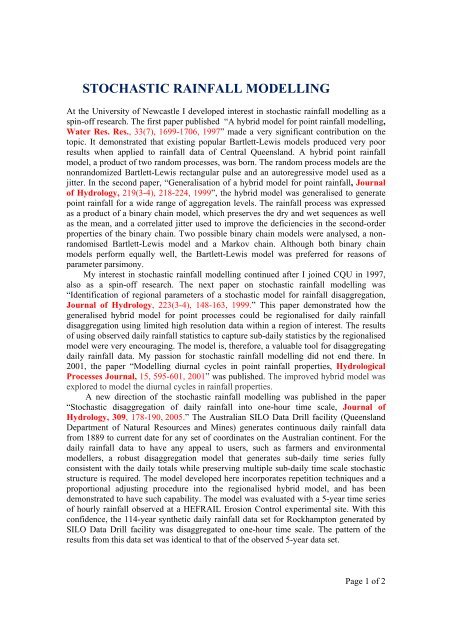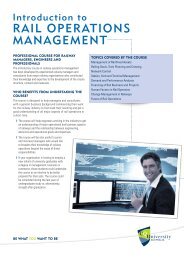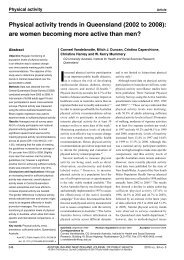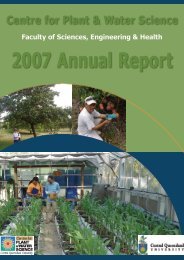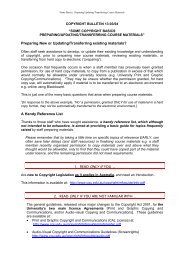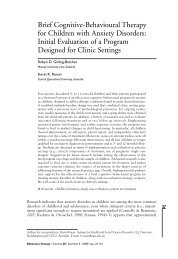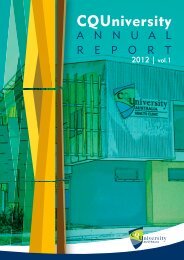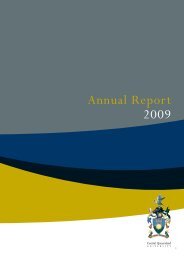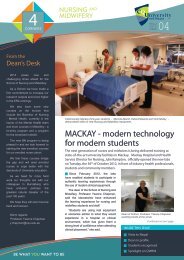stochastic rainfall modelling - Central Queensland University
stochastic rainfall modelling - Central Queensland University
stochastic rainfall modelling - Central Queensland University
You also want an ePaper? Increase the reach of your titles
YUMPU automatically turns print PDFs into web optimized ePapers that Google loves.
STOCHASTIC RAINFALL MODELLINGAt the <strong>University</strong> of Newcastle I developed interest in <strong>stochastic</strong> <strong>rainfall</strong> <strong>modelling</strong> as aspin-off research. The first paper published “A hybrid model for point <strong>rainfall</strong> <strong>modelling</strong>,Water Res. Res., 33(7), 1699-1706, 1997” made a very significant contribution on thetopic. It demonstrated that existing popular Bartlett-Lewis models produced very poorresults when applied to <strong>rainfall</strong> data of <strong>Central</strong> <strong>Queensland</strong>. A hybrid point <strong>rainfall</strong>model, a product of two random processes, was born. The random process models are thenonrandomized Bartlett-Lewis rectangular pulse and an autoregressive model used as ajitter. In the second paper, “Generalisation of a hybrid model for point <strong>rainfall</strong>, Journalof Hydrology, 219(3-4), 218-224, 1999”, the hybrid model was generalised to generatepoint <strong>rainfall</strong> for a wide range of aggregation levels. The <strong>rainfall</strong> process was expressedas a product of a binary chain model, which preserves the dry and wet sequences as wellas the mean, and a correlated jitter used to improve the deficiencies in the second-orderproperties of the binary chain. Two possible binary chain models were analysed, a nonrandomisedBartlett-Lewis model and a Markov chain. Although both binary chainmodels perform equally well, the Bartlett-Lewis model was preferred for reasons ofparameter parsimony.My interest in <strong>stochastic</strong> <strong>rainfall</strong> <strong>modelling</strong> continued after I joined CQU in 1997,also as a spin-off research. The next paper on <strong>stochastic</strong> <strong>rainfall</strong> <strong>modelling</strong> was“Identification of regional parameters of a <strong>stochastic</strong> model for <strong>rainfall</strong> disaggregation,Journal of Hydrology, 223(3-4), 148-163, 1999.” This paper demonstrated how thegeneralised hybrid model for point processes could be regionalised for daily <strong>rainfall</strong>disaggregation using limited high resolution data within a region of interest. The resultsof using observed daily <strong>rainfall</strong> statistics to capture sub-daily statistics by the regionalisedmodel were very encouraging. The model is, therefore, a valuable tool for disaggregatingdaily <strong>rainfall</strong> data. My passion for <strong>stochastic</strong> <strong>rainfall</strong> <strong>modelling</strong> did not end there. In2001, the paper “Modelling diurnal cycles in point <strong>rainfall</strong> properties, HydrologicalProcesses Journal, 15, 595-601, 2001” was published. The improved hybrid model wasexplored to model the diurnal cycles in <strong>rainfall</strong> properties.A new direction of the <strong>stochastic</strong> <strong>rainfall</strong> <strong>modelling</strong> was published in the paper“Stochastic disaggregation of daily <strong>rainfall</strong> into one-hour time scale, Journal ofHydrology, 309, 178-190, 2005.” The Australian SILO Data Drill facility (<strong>Queensland</strong>Department of Natural Resources and Mines) generates continuous daily <strong>rainfall</strong> datafrom 1889 to current date for any set of coordinates on the Australian continent. For thedaily <strong>rainfall</strong> data to have any appeal to users, such as farmers and environmentalmodellers, a robust disaggregation model that generates sub-daily time series fullyconsistent with the daily totals while preserving multiple sub-daily time scale <strong>stochastic</strong>structure is required. The model developed here incorporates repetition techniques and aproportional adjusting procedure into the regionalised hybrid model, and has beendemonstrated to have such capability. The model was evaluated with a 5-year time seriesof hourly <strong>rainfall</strong> observed at a HEFRAIL Erosion Control experimental site. With thisconfidence, the 114-year synthetic daily <strong>rainfall</strong> data set for Rockhampton generated bySILO Data Drill facility was disaggregated to one-hour time scale. The pattern of theresults from this data set was identical to that of the observed 5-year data set.Page 1 of 2
Recently the point process disaggregation model has been extended with thefollowing aims (Journal of Hydrology, 347, 358-370, 2007):• generalisation for any fine timescale at a point;• a simplified approach to determine the parameters of the regional model for avery large region such as the Australian continent;• evaluation of the uncertainty of the calibrated parameters;• enhancement of the capping procedure;• testing of an Australia-wide parameter set with 9 years continuous <strong>rainfall</strong> data of6-min timescale at a point.Page 2 of 2


